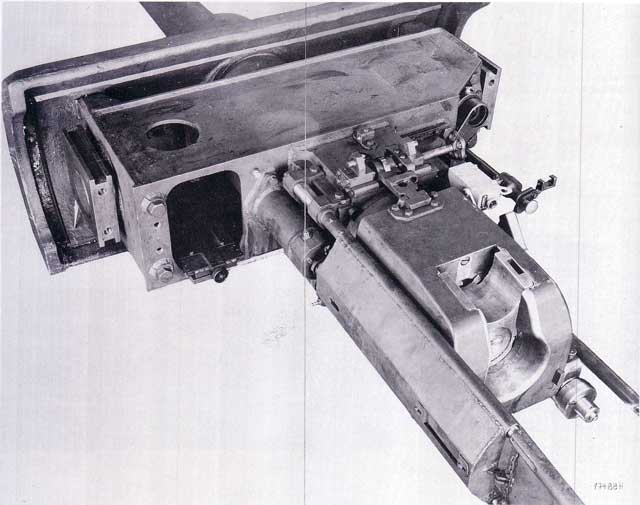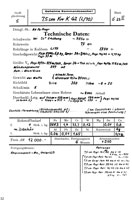
The main gun
7,5 cm Kampfwagenkanone 42 L/70
| Cover name | Feldberg | |
| Breech | semiautomatic, falling wedge | |
| Caliber | 75 mm | |
| Rate of fire | 6 rounds/min | |
| Effective range | 1100-1300 m | |
| Max. range | 10000 m | indirect fire |
| Caliber length | 70 | effective length of the barrel (from breech to muzzle) is divided by the barrel diameter |
| Length of the barrel | 5225 mm | |
| 5535 mm | incl. muzzle brake | |
| grooves | 32 | |
| Weight | barrel, inc. muzzle brake and breech | about1000 kg |
| gun, incl. mantlet | etwa 2650 kg | |
| Average barrel life | 2000-2400 rounds | 800 rounds if firing Panzergranate 40/42 |
| Elevation | - 8° bis + 20° | |
| Recoil length | 400 mm | max. 430 mm |
| Price per weapon | 12 000,-- Reichsmark | |
| Gun sight | Turmzielfernrohr 12 (binokular) | später Turmzielfernrohr 12 a (monokular) |
| Ammonition in stock | Ausf. D and A | 79 rounds |
| Ausf. G | 82 rounds | |
| Befehlswagen Ausf. D and A | 64 rounds | |
| Befehlswagen Ausf. G | 64 rounds |
Until the end of the war the backbone of the German Panzerwaffe was the 7,5cm Kampfwagenkanone (KwK) 40 L/48 numerically( e.g. in the Panzer IV H). With a penetration performance of 91 mm (108 mm) armor steel at 500 meters, it exceeded the 76.2 mm gun of the T-34 by 16 mm. A fight against Russian opponents with this weapon was reasonable at distances up to 1200 meters. The front armor of the "Stalin" tank, which appeared in 1944, could not be penetrated.
On July 18th 1941 Rheinmetall-Borsig in Dusseldorf had received the order to develop a gun with a penetration performance of 140 mm of steel armor at 1000 meters distance. As early as the beginning of 1942 a test barrel L/60, whose achievements were at the lower boundary of the required values from Army Ordnance was shot. Subsequently, the tube length has been increased to L/70. It was after a long trial, the 7,5cm KwK 42 L/70 gun, which was to be installed in the newly developed Panzerkampfwagen V (Sd. Kfz. 171) "Panther”.
Volume production should start in December 1942 with four pieces. None was completed until January 7th 1943, which was reasonable on initial problems with the gun and the gun sight Turmzielfernrohr 12 (binocular). Also the target of 50 guns in January 1943 could not be fulfilled; 25 units left the production halls. In May 1943 324 "Panther" were hastily shipped, which suffered additional difficulties with the complex binocular gun sight next to technical difficulties. It was later replaced by the monocular Turmzielfernrohr 12 a
In 1943 an amount of 1874 7,5cm KwK 42 L/70 guns and 1944/45 4557 guns could be delivered. Monthly production reached its peak with 300 pieces in August 1944.
The impressive performance of the gun (124 mm or 174 mm armor plate at 500 m distance) were bought with an average barrel life of 2000 rounds, or only 800 rounds using the Panzergranate 40/42. For comparison: the 7,5-cm 37 L/24 KwK had an average barrel life of 12-14000 rounds. The production of the Armor Piercing Composite Rigid, tungsten core, has been discontinued in July 1943 indeed. The reason was an acute shortage of tungsten, as well as the fact, that the penetration performance of the 7,5cm Pzgr. 39/42 was completely enough up to 1500 m. The front armor of the T-34, "Churchill" and "Sherman" could be pierced with devastating effect within this range.
Thereby 4 hits out of 10 shots were expected. At 500 meters a hit rate of 100% resulted. To clarify the improvement of performance lets to look back into the August 1942. In a field report the 5th Armored Division complained that when using the 7,5-cm 37 L/24 gun five to eight rounds were necessary to kill an enemy tank.
As early as January 1943, the” Merkblatt für die Munition der 7,5- cm- Kampfwagenkanone 42 und der 7,5- cm- Sturmkanone 42, H.Dv. 481/55” (ammunition manual) and the associated “Schusstafel (H.Dv.119/325)“ were released
The main variant of the 7,5-cm-KwK 42 L/70 was the previously mentioned 7,5-cm-Sturmkanone 42 L/70 (StuK), which was installed in the Jagdpanzer IV (Sd. car came. 162 / 1 and 2.
The 7,5cm KwK 44/1 L/70 was developed by Skoda in Plzeň (Pilsen), Czech Republic, for the Panther Ausf. F . Equipped with a "Saukopfblende" a weight of 1920 kg resulted.
The Turmzielfernrohr 13 (monocular) had 2,5x - and 6x-magnification. The most important innovation, however, was the installation of a stereoscopic rangefinder, which should help to increase the accuracy when shooting at distances over 2000 meters.
Furthermore, the 7,5- cm- Kampfwagenkanone 44/2 L/70 has been tested with an automatic loader. The weight was 3400 kg; three units were built.
Should be mentioned as an alternative solution to a gun fight with a high penetration, continues to the 7.5 - inch gun battle tanks 41 (unit 0725). She had been taken in the spring of 1941 as the main weapon of the VK 3601 (H), the forerunner of the "tiger" in the preamble. Krupp received on 25 May 1941 to construct an order for this weapon a tower.
Dismantled KwK from the Panzermuseum at Munster |
||
| Gun with breech in rearmost position, as if the barrel recoil was fulfilled after firing the gun | ||
|
|
||
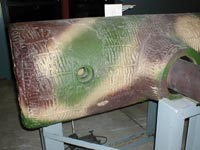 |
 |
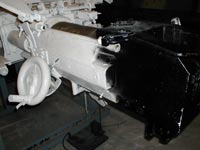 |
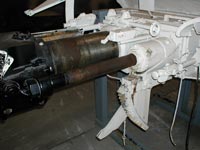 |
 |
|
|
Variante of the mantlet
|
||
7,5 cm Kampfwagenkanone 42 L/70 |
|||
| Tarnbezeichnung |
Feldberg
|
||
| Funktionsweise |
halbautomatisch, Fallblockverschluss
|
||
| Kaliber |
75 mm
|
||
| Feuergeschwindigkeit |
6 Schuss/min
|
||
| Schussweite im direkten Richten |
1100-1300 m
|
||
| Höchstschussweite |
10000 m
|
||
| Rohrlänge in Kaliber |
70
|
Kaliberlänge = Rohrlänge geteilt durch Kaliber
|
|
| Rohrlänge in mm |
5225 mm
|
||
|
5535 mm
|
mit Mündungsbremse
|
||
| Anzahl der Züge |
32
|
||
| Gewicht |
Rohr, vollständig mit Verschluss und Mündungsbremse
|
etwa 1000 kg
|
|
|
Geschütz, vollständig mit Panzerblende
|
etwa 2650 kg
|
||
| Lebensdauer, Rohr |
2000-2400 Schuss
|
bei Verschuss der Panzergranate 40/42 800 Schuss
|
|
| Höhenrichtfeld in Grad |
- 8° bis + 20°
|
||
| Rücklauflänge, normal |
400 mm
|
||
| Preis je Waffe |
12 000,-- Reichsmark
|
||
| Zieleinrichtung |
Turmzielfernrohr 12 (binokular)
|
später Turmzielfernrohr 12 a (monokular)
|
|
| Munitionsvorrat | Ausf. D und A |
79 Patronen
|
|
| |
Ausf. G |
82 Patronen
|
|
| |
Befehlswagen Ausf. D und A |
64 Patronen
|
|
| |
Befehlswagen Ausf. G |
64 Patronen
|
|




